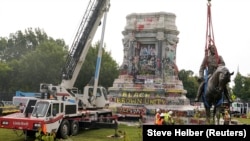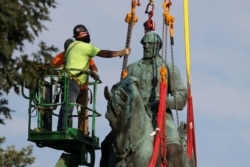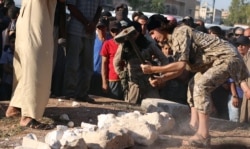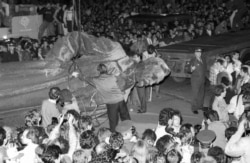On October 29, the Russian government-owned agency RT (formerly Russia Today) published an op-ed on the removal of monuments associated with slavery and racism in the United States.
The RT contributor, Brendan Heard, focused his piece on a proposal that the African American Heritage Center in Virginia submitted to the Charlottesville, Virginia, city council. The center suggested that a bronze statue of Confederate Gen. Robert E. Lee be melted down and used to create a piece of art.
Heard equated the running controversy over statues of Confederate figures in the U.S. with the wanton destruction that Islamic State terrorists caused in Syria.
“Melting statues to create modern art is a sign America hates its own history & no different from ISIS destroying Palmyra,” Heard wrote.
That claim is false. In fact, they are quite different.
“It is absurd to compare a proposal raised for discussion in a democratic process to ISIS's violent and authoritarian occupation and destruction of monuments at Palmyra,” Virginia Herrmann, an archeologist with the Institute for Ancient Near Eastern Studies at the University of Tubingen in Germany, told Polygraph.info.
“Context and process are meaningful when it comes to engagement with monuments, and this comparison ignores both,” Herrmann said.
Monuments to Lee, the rebel military leader in the U.S. Civil War, and other Confederate leaders have become controversial. Many see them as symbols glorifying racism, slavery and oppression, while others celebrate them as tributes to the heritage of the American South.
African-American and progressive activists advocated for the removal of Lee monuments and other Confederate relics across the country as part of a campaign for historical justice, and to condemn racism and recognize the contribution of African slaves to America’s prosperity.
The debate over Confederate symbols has been going on for decades, engaging activists, intellectuals, celebrities, politicians and government officials. Beyond moving statutes, it has involved renaming highways as well as counties, cities, streets, schools and colleges.
“Monuments are sites of power contestation, of memory politics. The monument-maker has the resources and authority to impose on public spaces their view of who and what is to be celebrated or condemned,” Herrmann and archeologist Giuliana Paradiso wrote in an essay.
The controversy around Confederate symbols escalated in 2020, when protests erupted across the country after the death of George Floyd, a Black man who had been pinned to the ground with a neck chokehold by Minneapolis police officer Derek Chauvin.
Some 168 Confederate symbols were removed across the United States in 2020 alone, more than all previous years combined, Statista reported.
At times, the controversy has escalated to violence, as in 2017, when scores of white supremacists and right-wing activists gathered in Charlottesville. A 32-year-old woman was killed and about 40 were injured during the clashes between nationalists and Black and anti-racism activists. Two police officers died in a helicopter crash while patrolling the events.
As of June 2021, 170 Confederate monuments had been removed across the United States, the Southern Poverty Law Center reported. Still, more than 700 Confederate monuments remain in public spaces across the country, the SPLC said.
Most of the relics were relocated to museums or temporary locations. Discussion of what to do with them is ongoing, and melting them down to create new art is just one suggested option. Others include keeping them in museums for display in the context of historical racism.
Herrmann argues that the monuments are not themselves history, but “public value statements about that past.”
“The memory of Lee and his role in the Civil War is not threatened by this proposal” to re-cast the Charlottesville statue anew, she said.
In Iraq and Syria, Islamic State terrorists destroyed numerous ancient sites and artifacts that the United Nations had designated as world heritage relics of outstanding universal value.
Among them was Palmyra, described by the United Nations Educational, Scientific and Cultural Organization (UNESCO) as “[a]n oasis in the Syrian desert, north-east of Damascus, Palmyra contains the monumental ruins of a great city that was one of the most important cultural centers of the ancient world.”
UNESCO Director General Irina Bokova described the damage to Palmyra as “a new war crime and an immense loss for the Syrian people and for humanity.”
“This new blow against cultural heritage, just a few hours after UNESCO received reports about mass executions in the theatre, shows that cultural cleansing led by violent extremists is seeking to destroy both human lives and historical monuments to deprive the Syrian people of its past and its future,” Bokova said.
Mbaraz Ahmed, a senior analyst at Tony Blair Institute for Global Change, wrote in September 2015 that there were several reasons for Islamic State’s destruction of historic relics. Among them was the group’s Salafi ideology, which emphasizes “monotheism (Tawhid) and eradicating any form of association with God (Shirk or polytheism),” Ahmed wrote.
Another was Islamic State’s sectarianism. “Sites belonging to Shia, Kurdish, Yezidi and Christian communities have been subjected to destruction and looting,” Ahmed wrote. “The clear message is that they are now irrelevant; the cultural and ethnic legacies of these people have no place in the ‘caliphate.’”
Islamic State also sought to make money. According to a UNESCO estimate, Islamic State looted artifacts worth more than $2 billion to be smuggled and sold in shadow markets.
“The destruction wreaked by ISIS is an attack on the shared history of human civilization, and as such is just as much an affront to Muslims as it is to the rest of the world,” Ahmed wrote.
Russia has its own history of destroying monuments and symbols.
Following the 1917 Bolshevik Revolution, the Soviet authorities erased public displays of Russia’s imperial past, including Orthodox Churches and other religious symbols.
After Soviet dictator Josef Stalin died in 1953, thousands of Stalin statues were removed. When the Soviet Union collapsed in 1991, statues of Bolshevik leader Vladimir Lenin and secret police founder Felix Dzerzhinsky were removed, as were other communist symbols.










